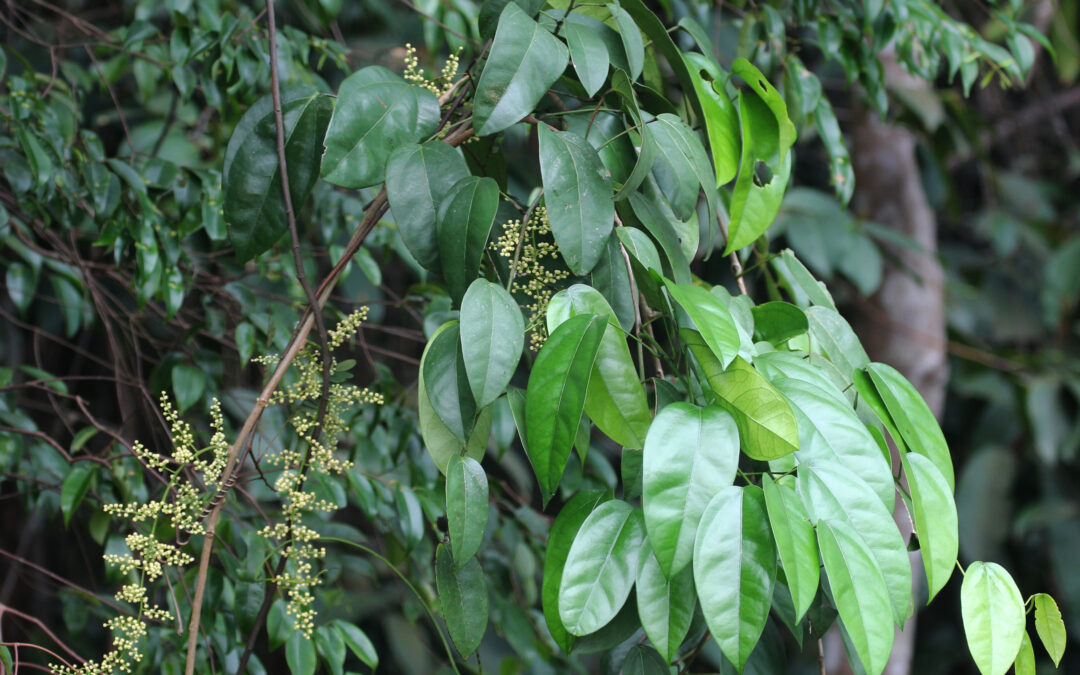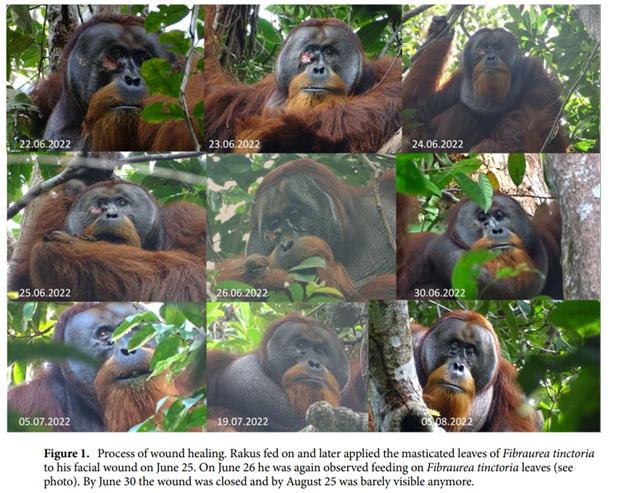Guest blog by M. Mark Melin MD and Davis Melin MPH
A recent Nature article entitled “Active self‑treatment of a facial wound with a biologically active plant by a male Sumatran orangutan”1 is a fascinating description of Rakus, a mature, male orangutan who lives in the wild in an Indonesian national park. Photographs show a wound on his right face, possibly sustained in a fight with another male orangutan.
A series of photos show Rakus’ wound care regimen and its results. The report states that for several days, he chewed on the leaves of a plant called Fibraurea tinctoria and applied the resulting poultice to his face. Within 5 days the wound was closed, and within 4 weeks, the affected area was barely visible. This is believed to be the first observation of a primate using a plant as a medicinal treatment.
Here’s the most fascinating part. Of all the plants in the forest, Rakus selected Fibraurea tinctoria to treat his wound. This plant contains the isoquinoline alkaloid Berberine. Berberine is currently receiving a lot of attention from the scientific community because of its antidiabetic and antioxidant activities. In fact, Berberine has been used by humans for over 400 years as part of traditional Chinese, Indian, and Middle-Eastern folk medicine. It is present in many traditional medicinal plants,2 and its many useful properties include the protection of the endothelial glycocalyx which lines all 60,000 miles of our arteries, veins and lymphatics — and which may be the unrecognized key to vascular health.
The use of natural products as complementary or alternative medicines is gaining worldwide popularity. Frankly, it could be argued that these natural substances –which have been used for hundreds of years by humans (and possibly by other primates!)– are the “conventional” treatments and the non-plant based and non-naturally occurring medications we prescribe daily are the “alternative” treatments!
In the Garden of Eden, two trees are described: the tree of the Knowledge of Good and Evil, and the Tree of Life. Fruit was eaten from the former tree, and the outcome of that experiment was not-so-good. We suspect that the second tree was a plant-based solution to a completely healthy life. Unfortunately, we can’t prescribe that fruit, but we can prioritize healthy eating for our patients and take advantage of natural products which have uniquely beneficial effects. Do you ask your patients what they eat and drink? Have you considered recommending supplements like flavonoids that support endothelial function which may be the key to wound healing and to cardiovascular health? Technological advances are wonderful, but we should not neglect the basics like nutrition and possibly some relatively inexpensive, natural substances.
Rakus, thank you for teaching us more about the natural world, and for making us pause and wonder at the miracle of healing.
Most respectfully,
the Human Primates
https://doi.org/10.1038/s41598-024-58988-7 This article is licensed under a Creative Commons Attribution 4.0 International License, which permits use, sharing, adaptation, distribution and reproduction in any medium or format, as long as you give appropriate credit to the original author(s) and the source, provide a link to the Creative Commons license, and indicate if changes were made.
References
- Sabelle B. Laumer, Arif Rahman, Tri Rahmaeti, UlilAzhari , Hermansyah, Sri Suci UtamiAtmoko & Caroline Schuppli. Active self‑treatment of a facial wound with a biologically active plant by a male Sumatran orangutan. Scientific Reports | (2024) 14:8932 | https://doi.org/10.1038/s41598-024-58988-7
- Purwaningsih, I.; Maksum, I.P.; Sumiarsa, D.; Sriwidodo, S. A Review of Fibraurea tinctoria and Its Component, Berberine, as an Antidiabetic and Antioxidant. Molecules 2023, 28, 1294. https://doi.org/10.3390/molecules28031294
The opinions, comments, and content expressed or implied in my statements are solely my own and do not necessarily reflect the position or views of Intellicure or any of the boards on which I serve.




